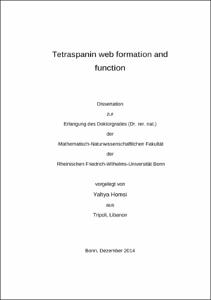Homsi, Yahya: Tetraspanin web formation and function. - Bonn, 2015. - Dissertation, Rheinische Friedrich-Wilhelms-Universität Bonn.
Online-Ausgabe in bonndoc: https://nbn-resolving.org/urn:nbn:de:hbz:5n-39467
Online-Ausgabe in bonndoc: https://nbn-resolving.org/urn:nbn:de:hbz:5n-39467
@phdthesis{handle:20.500.11811/6439,
urn: https://nbn-resolving.org/urn:nbn:de:hbz:5n-39467,
author = {{Yahya Homsi}},
title = {Tetraspanin web formation and function},
school = {Rheinische Friedrich-Wilhelms-Universität Bonn},
year = 2015,
month = mar,
note = {The cell membrane is crucial for living cells; it encloses the intracellular matrix, maintains the concentration of cytosolic components, and controls the in-/outward signalling and interaction pathways. The cell membrane consists mainly of lipids and proteins. Membrane proteins are involved in essential physiological functions of the cell; in addition, they have the ability to organize, interact and assemble laterally to form clusters or platforms that are biologically important for cell function. The mechanisms underlying membrane protein organization and assembly in clusters are still not completely understood.
Tetraspanins are a family of membrane proteins exhibiting a particularly high propensity to interact with each other or with partner proteins to form so-called tetraspanin enriched microdomains (TEM) or tetraspanin webs. TEMs are involved in pathogen infections, creating entry and exit platforms, and promote different stages of cancer. Until now, the mechanism of TEM assembly is poorly understood. All tetraspanin family members share a similar molecular structure that comprises four transmembrane domains, intracellular N- and C-termini, a very short intracellular loop, a small extracellular loop (SEL), and a large extracellular loop (LEL), which is further subdivided in five helical domains, the α-, β-, γ-, δ- and ε-domain.
CD81 is an ubiquitously expressed tetraspanin; it is the best studied tetraspanin and one of the most important family members. CD81 plays a crucial role in TEM building and can form with its partner proteins large tetraspanin webs that play physiological roles in different cellular functions and regulate diverse cellular processes. Here, I examined which part of the CD81 molecule is required for protein clustering and protein organization leading to formation of tetraspanin microdomains in the plasma membrane of T cells and hepatocytes. Astonishingly, I find that the organization and assembly of large CD81 platforms are driven by the short extracellular δ-domain of CD81-LEL, independent from the strong primary interactions with partner proteins as well as the secondary weak stabilizing interactions mediated by palmitoylation. Moreover, the δ-domain is not only necessary for protein clustering but it is also essential for platform function and viral entry. Here, a new model of tetraspanin web formation was presented, in which the δ-domain plays the key role for protein clustering, tetraspanin web organization and function. This model is based on specific interactions via the δ-domain, possibly including a protein dimerization step, to control the organization of tetraspanins into large webs and to regulate their function, instead of stable binary interactions as described by the classical view of TEM organization.},
url = {https://hdl.handle.net/20.500.11811/6439}
}
urn: https://nbn-resolving.org/urn:nbn:de:hbz:5n-39467,
author = {{Yahya Homsi}},
title = {Tetraspanin web formation and function},
school = {Rheinische Friedrich-Wilhelms-Universität Bonn},
year = 2015,
month = mar,
note = {The cell membrane is crucial for living cells; it encloses the intracellular matrix, maintains the concentration of cytosolic components, and controls the in-/outward signalling and interaction pathways. The cell membrane consists mainly of lipids and proteins. Membrane proteins are involved in essential physiological functions of the cell; in addition, they have the ability to organize, interact and assemble laterally to form clusters or platforms that are biologically important for cell function. The mechanisms underlying membrane protein organization and assembly in clusters are still not completely understood.
Tetraspanins are a family of membrane proteins exhibiting a particularly high propensity to interact with each other or with partner proteins to form so-called tetraspanin enriched microdomains (TEM) or tetraspanin webs. TEMs are involved in pathogen infections, creating entry and exit platforms, and promote different stages of cancer. Until now, the mechanism of TEM assembly is poorly understood. All tetraspanin family members share a similar molecular structure that comprises four transmembrane domains, intracellular N- and C-termini, a very short intracellular loop, a small extracellular loop (SEL), and a large extracellular loop (LEL), which is further subdivided in five helical domains, the α-, β-, γ-, δ- and ε-domain.
CD81 is an ubiquitously expressed tetraspanin; it is the best studied tetraspanin and one of the most important family members. CD81 plays a crucial role in TEM building and can form with its partner proteins large tetraspanin webs that play physiological roles in different cellular functions and regulate diverse cellular processes. Here, I examined which part of the CD81 molecule is required for protein clustering and protein organization leading to formation of tetraspanin microdomains in the plasma membrane of T cells and hepatocytes. Astonishingly, I find that the organization and assembly of large CD81 platforms are driven by the short extracellular δ-domain of CD81-LEL, independent from the strong primary interactions with partner proteins as well as the secondary weak stabilizing interactions mediated by palmitoylation. Moreover, the δ-domain is not only necessary for protein clustering but it is also essential for platform function and viral entry. Here, a new model of tetraspanin web formation was presented, in which the δ-domain plays the key role for protein clustering, tetraspanin web organization and function. This model is based on specific interactions via the δ-domain, possibly including a protein dimerization step, to control the organization of tetraspanins into large webs and to regulate their function, instead of stable binary interactions as described by the classical view of TEM organization.},
url = {https://hdl.handle.net/20.500.11811/6439}
}






